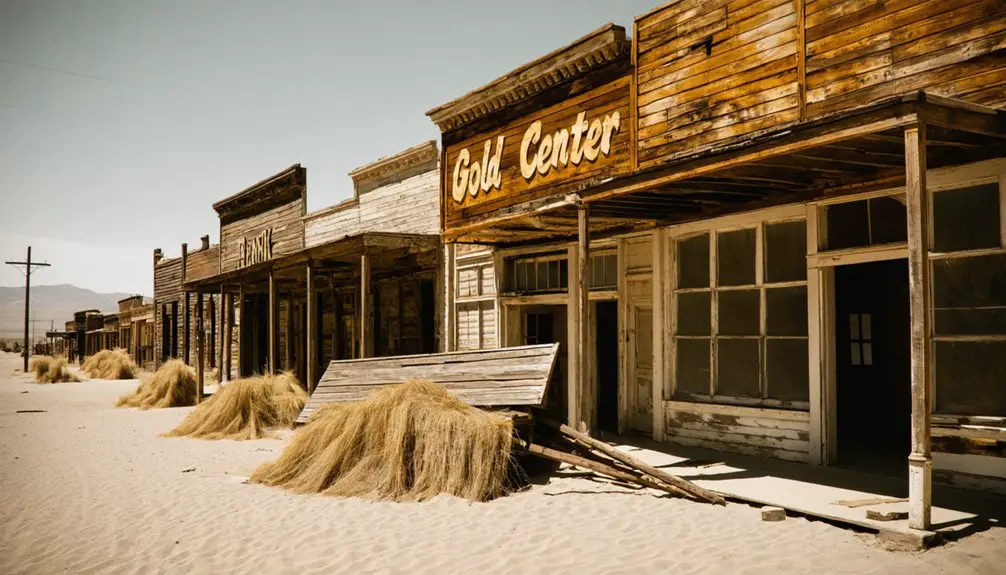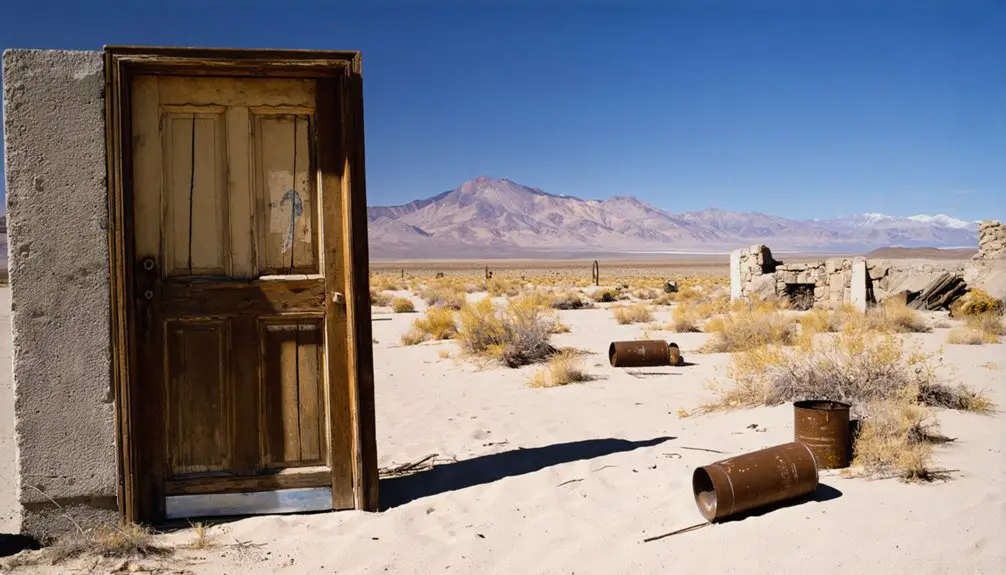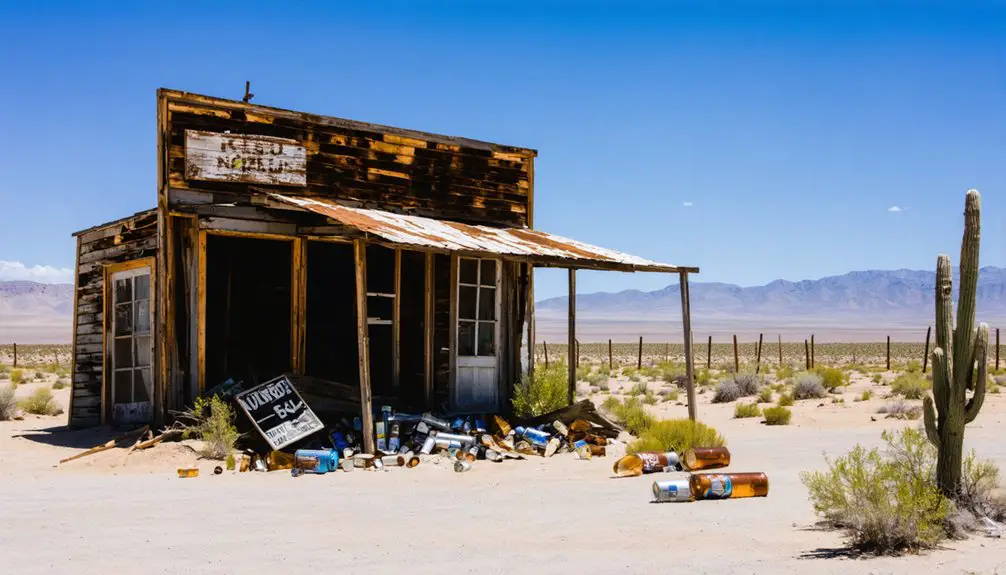You’ll find Gold Center’s ruins three miles south of Beatty, Nevada, where this 1904 boomtown once served as an essential hub during the Bullfrog mining rush. Beyond its scattered concrete foundations and mill remnants, Gold Center distinguished itself with innovative infrastructure, including stamp mills, water pipelines, and three major rail terminals. While the Panic of 1907 triggered its decline, the site’s artifacts reveal a sophisticated desert settlement that transcended typical mining camp operations.
Key Takeaways
- Gold Center, established in 1904 during Nevada’s Bullfrog mining rush, focused on supporting nearby mines rather than extracting its own minerals.
- The town’s strategic location near the Amargosa River made it a crucial transportation hub with three rail terminals and stagecoach routes.
- At its peak in 1907, Gold Center boasted stamp mills, an ice plant, brewery, banks, and mercantile stores serving the mining community.
- The Panic of 1907 triggered the town’s decline through financial instability and falling mining investments, leading to widespread abandonment.
- Today, concrete ruins, mill foundations, and water pipeline remnants can be found three miles south of Beatty, Nevada.
The Birth of a Desert Townsite
When the Bullfrog mining rush swept through Nevada in late 1904, Gold Center emerged as a strategic settlement near the life-sustaining Amargosa River.
You’ll find that while other boomtowns like Rhyolite quickly outpaced its development, Gold Center’s access to water gave it a unique advantage in tackling the mining challenges of Nevada’s harsh desert environment.
Unlike many hastily established mining camps that struggled with water scarcity, Gold Center’s position along the Amargosa River allowed it to develop distinctive infrastructure.
Gold Center thrived where other desert mining camps faltered, its riverside location enabling vital infrastructure development in Nevada’s arid landscape.
You can trace its early growth through the establishment of essential facilities like stamp mills and supply routes. The town became one of Nevada’s many resource-driven boomtowns during this period, much like Silver Point which thrived in the 1860s.
Though it wasn’t the district’s largest settlement, the town’s strategic location made it an important hub for processing ore and distributing critical resources to neighboring communities.
Railroad Arrival and Economic Growth
As the Las Vegas & Tonopah Railroad began construction through Gold Center in June 1906, the town’s destiny as an essential transportation hub took shape.
The railroad expansion transformed the desert outpost, bringing the first passenger train by October 7th and establishing crucial connections for mining transportation throughout the region.
Located at 3,143 feet elevation, the town’s higher altitude provided strategic advantages for rail operations and regional transportation.
The Gold Center Ice & Brewing Company became a vital business, producing distilled water ice for the entire Nevada region.
You’ll find the impact of the railroads evident in three key developments:
- Two competing rail lines – the Las Vegas & Tonopah and Tonopah & Tidewater – created a robust transportation network
- Local industry flourished with new stamp mills, ice plants, and breweries
- The town maintained economic stability even during the Panic of 1907, thanks to its strategic rail connections
Life in Gold Center’s Glory Days
The vibrant town of Gold Center reached its zenith in 1907, boasting an extensive array of amenities that served both residents and neighboring communities.
At its peak in 1907, Gold Center flourished as a bustling hub, providing vital services throughout the region.
You’d find a bustling financial district with a bank and brokerage firms handling mining stock transactions, while mercantile stores supplied essential goods. The town’s score of saloons became focal points for social gatherings, where miners and workers could enjoy locally brewed beer from the Gold Center Ice and Brewing Company. Like its neighbor Goldfield, the town attracted many fortune seeking miners. Similar to its counterpart Gold Point, the area saw its first settlers arrive as early ranchers in the 1880s.
Economic activities centered around the town’s unique industrial ventures. The brewery, doubling as Nevada’s only distilled water ice plant, supplied both Gold Center and Rhyolite’s drinking establishments.
Two stamp mills processed ore, while water pipelines sustained neighboring communities. You’d witness a hive of commerce and industry, all powered by the precious Amargosa River in this otherwise arid landscape.
Industrial Development and Mining Operations
Established during the 1904 Bullfrog mining rush, Gold Center’s industrial development focused more on supporting neighboring mines than extracting its own minerals.
You’ll find its strategic position near the Amargosa River enabled essential mining techniques through water distribution to nearby camps like Rhyolite and Carrara.
The town’s industrial innovations included:
- Two stamp mills for processing ore from surrounding mines
- An ice plant and brewery utilizing the river’s water supply
- Advanced pipeline systems delivering water to mining operations
Similar to Elko’s role as a major freighting center, Gold Center served as a vital supply and processing hub for the region’s mines.
When the Las Vegas & Tonopah Railroad arrived in 1906, you could see Gold Center transform into a critical transportation hub.
Though the town never struck significant gold deposits itself, it thrived briefly through its industrial support services before declining when rail lines extended to larger mining towns.
The town’s industrial legacy was short-lived, as by 1910 serious decline had already set in.
Transportation Hub and Regional Connections
Gold Center’s emergence as a essential transportation nexus began with the arrival of the Las Vegas & Tonopah Railroad in October 1906, quickly followed by the Tonopah & Tidewater and Bullfrog Goldfield lines.
You’ll find evidence of the town’s strategic importance in its convergence of three major rail terminals and established stagecoach routes, which facilitated movement between key mining districts like Rhyolite and Beatty.
The town’s position near the Amargosa River enabled it to serve as an important supply distribution point, with its ice plant, brewery, and water infrastructure supporting both local industries and regional transportation networks.
The T&T’s service improved regional connectivity when it merged with Bullfrog in 1908, offering faster travel times between destinations.
High operating expenses and disappointing ore shipments from the region’s mines ultimately contributed to the railroad’s financial struggles.
Railroad Terminus Operations
When rail service commenced at Gold Center in October 1906, the arrival of the first work train marked the beginning of a vital transportation hub that would connect Nevada’s northern and southern mining districts.
The railroad logistics centered around a temporary rail yard that managed cargo transfers until Rhyolite’s completion. You’ll find that both the Tonopah & Tidewater and Bullfrog Goldfield railroads established freight services here by year’s end.
Key operational features included:
- Up to four daily passenger runs on the Bullfrog-Goldfield line
- Direct connections to Las Vegas southbound and California westbound
- Strategic transfer points for east-west movement of goods and ores
This rail junction revolutionized regional transport, markedly reducing costs and travel times for mining operations while integrating remote camps into broader commercial networks.
Stagecoach Route Significance
As stagecoach operations expanded across Nevada’s southern mining district in 1905, the strategic location of this desert outpost transformed it into an important transportation nexus.
You’d find stagecoach logistics carefully planned around water sources and natural mountain passes, connecting Gold Center to neighboring boomtowns like Rhyolite and Bullfrog.
The harsh desert environment presented significant passenger challenges, with cramped coaches carrying up to nine travelers through dusty, rough terrain. Each passenger could only bring 25 pounds of luggage, but you’d see these coaches hauling everything from mining supplies to mail.
The town’s position along major transport corridors made it a vital link between California and Utah, spurring the growth of local businesses like hotels and blacksmith shops that served the steady flow of travelers.
Regional Supply Distribution
Building upon its stagecoach foundations, the Las Vegas & Tonopah Railroad’s arrival in June 1906 established Gold Center as a dominant supply distribution hub for Nevada’s southern mining district.
The town’s strategic location and dual railroad service strengthened its supply chain capabilities, providing critical logistical support to Rhyolite, Bullfrog, and Beatty.
You’ll find Gold Center’s regional influence was enhanced by three key advantages:
- Access to the Amargosa River’s water supply, enabling ice production and brewing operations
- Two operational stamp mills that processed ore from surrounding camps
- Integration of rail and stage routes that created efficient transportation networks
Through these assets, Gold Center flourished as a processing center and freight distribution point, connecting mining districts to essential supplies and downstream markets during the region’s boom years.
The Impact of the 1907 Financial Crisis

The devastating Panic of 1907 struck Gold Center during a critical period of its development, bringing severe economic hardships to the fledgling mining community.
Like many western boom towns, you’d have found Gold Center particularly vulnerable to economic downturns, as mining operations depended heavily on consistent capital investment and stable markets.
When the panic triggered widespread financial instability, trust companies critical to mining development saw their reserves plummet to dangerous levels.
You can trace Gold Center’s decline through the physical evidence: half-finished buildings, abandoned mining equipment, and incomplete railroad spurs that still dot the landscape today.
The town’s population dwindled rapidly as unemployment soared to 8% nationally, and many miners were forced to seek opportunities elsewhere, leaving behind a ghost town that serves as a stark reminder of the panic’s far-reaching effects.
From Boom Town to Abandonment
Gold Center’s story began with promise in 1904, when founders strategically positioned the settlement near the Amargosa River to support the surrounding Bullfrog mining district.
Unlike its flashier neighbors, Gold Center built its reputation on desert infrastructure rather than gold mining, establishing essential services that kept the region’s operations running.
Key developments that marked Gold Center’s evolution:
- Construction of two stamp mills and water pipelines to Rhyolite and Carrara
- Development of an ice plant and brewery capitalizing on water resources
- Connection to major railroad lines, including the Las Vegas & Tonopah Railroad by 1906
You’ll find that Gold Center’s fate was ultimately tied to the broader mining district’s success.
As nearby boom towns declined and mining activity decreased, the demand for Gold Center’s support services dwindled, leading to its eventual abandonment.
Modern-Day Remnants and Historical Significance

Standing three miles south of Beatty, Nevada, the physical remnants of Gold Center tell a story of industrial innovation rather than mineral wealth.
You’ll find concrete ruins and mill foundations scattered across steep hillsides west of Highway 95, where two stamp mills once processed ore from the bustling Bullfrog district.
While Gold Center never struck it rich with gold deposits, it thrived as an essential water supply hub, tapping the Amargosa River to serve neighboring boomtowns.
The town’s strategic location attracted the Las Vegas & Tonopah Railroad in 1906, transforming it into a significant transportation center.
You can still trace the town’s industrial heritage through its surviving infrastructure – from water pipeline remnants to brewery foundations.
Today, this ghost town’s ruins stand as silent witnesses to Nevada’s resourceful mining era.
Frequently Asked Questions
What Were the Average Temperatures and Climate Conditions in Gold Center?
You’ll experience temperature extremes from 64-93°F in summer, with hot days and cool nights. Climate patterns show minimal rainfall, making survival challenging in these harsh desert conditions.
Did Any Notable Crimes or Lawlessness Occur in Gold Center?
You’d be amazed how peaceful this frontier town was – historical records don’t show any major crime incidents or need for substantial law enforcement despite having twenty saloons at its peak.
How Much Did Typical Goods and Services Cost in Gold Center?
You’d find local draft beer and ice readily available, with meals costing typical frontier prices. Hotel rooms ran $1-3 nightly, while postal services cost pennies to dimes per transaction.
Were There Any Schools or Churches Established in Gold Center?
You won’t find any records of school establishments or church communities in this short-lived boomtown. The town’s industrial focus and brief peak around 1907 prioritized mills and breweries over social institutions.
What Happened to Gold Center During World War I?
You’ll find that while gold production continued at Gold Center’s mills during WWI, the war’s impact was minimal. The town maintained its small role as a transport hub but didn’t experience significant growth.
References
- https://travelnevada.com/ghost-town/gold-point-ghost-town/
- https://nvtami.com/2023/05/09/ghost-towns-of-beatty/
- https://www.legendsofamerica.com/nv-deathvalleyghosttownnevada/
- https://westernmininghistory.com/towns/nevada/gold-center/
- https://www.nevadaappeal.com/news/2017/feb/16/all-that-glitters-isnt-always-golden/
- https://www.smithsonianmag.com/sponsored/nevadas-living-and-abandoned-ghost-towns-180983342/
- https://artsandculture.google.com/story/american-ghost-towns-goldfield-nevada/dwUxMOTucNEDqg?hl=en
- https://www.nps.gov/parkhistory/online_books/deva/section4a7.htm
- https://www.nvexpeditions.com/nye/goldcenter.php
- https://travelnevada.com/historical-interests/goldfield-historic-bullfrog-goldfield-railroad-yard/



